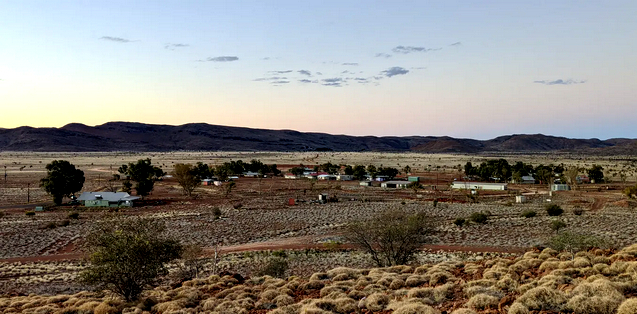
|
|
View of Kalka. Liam Grealy, Author provided (no reuse) |
|
Authors
|
Take the Aṉangu Pitjantjatjara Yankunytjatjara (APY) Lands in northwest South Australia, where maximum temperatures are increasing. The summer periods of sustained high temperatures are starting earlier and lasting longer.
A rapidly warming planet provides a significant challenge to design, deliver, and maintain habitable housing across Australia. Yet, few analyses consider Indigenous housing and climate change together.
A new report, Sustainable Indigenous Housing in Regional and Remote Australia, fills this gap.
Exploring sustainable housing for First Nations communities
This new report examines the role of housing in remote and regional communities, given the increasing pressures of climate change. It shows existing and new housing can and should be better maintained for these communities. We found that Indigenous-run tenancy management is part of the solution.
In Gunnedah, we partnered with Gunida Gunyah Aboriginal Corporation, an Aboriginal community housing provider in New South Wales. The houses that Gunida Gunyah manage vary in age and quality, which all housing organisations must negotiate as they assume responsibility for ongoing maintenance.
Unfortunately the legacies of inadequate construction in housing do not belong to the past. What is built or refurbished today could haunt residents for decades. So, will attempts to revive old housing using existing national construction guidelines be enough to ensure future habitability?
Aboriginal Housing in Australia is drastically underfunded, overcrowded, and of poor quality. Its not good enough now, but will become completely unlivable with rising temperatures. We need investment in Public Housing, and Climate Justice, starting now. https://t.co/1LYQtCz1uOWe used simulation software to understand the impact of climate change, especially of increasing heat, on Indigenous housing. This software considered the effectiveness of strategies for refurbishing existing housing to improve thermal performance and energy efficiency. This simulation was modelled for Australia’s tropical, dry, and hot/mild climate zones.
— Housing for the Aged Action Group (@HAAGHomeAtLast) November 9, 2021
After 366 simulations, our results showed modifying or refurbishing existing housing and even building new homes to meet recommended standards are not adequate measures for current or future climate changes. Even if existing housing was improved or new housing was built to current national construction code standards, at best, benefits will be short term.
Further, whether houses are old or new, crowding is a critical limitation for “thermal comfort” - the technical term for not too hot, not too cold. So, even if housing was greatly improved on the design front, crowding would cancel out the benefits.
The solution is a combination of better design and construction standards, increased housing and restorative work on existing housing, with well-funded repair and maintenance programs to ensure ongoing function.

|
|
Newly built house in APY Lands.
Liam Grealy, Author provided (no reuse)
|
As Healthabitat has long demonstrated, basic needs for householders, such as the ability to wash themselves, wash clothes and bedding, and store and prepare food, requires things to work inside and outside the house.
Decades of data shows the impact of restoring function to health hardware (washing facilities, safe food storage systems, and so on) and reveals the key reasons for housing dysfunction are poor original construction and inadequate repairs and maintenance.
Some governments respond to evidence of poor maintenance by claiming that the rent they can collect is not enough to cover the expenses involved, or that the record-keeping systems for showing what needs to be repaired are at fault, especially in remote areas.
However, our case material from the APY Lands shows the holy grail of proactive and planned maintenance of housing is perfectly doable and can generate savings.
A preventive maintenance program is economical. It minimises major hardware failures, bundles work orders (so more is fixed in less time) and reduces travel costs.
By spending three-quarters of its maintenance budget for APY Lands housing on planned works, and working closely with the Indigenous community-controlled Nganampa Health Council, Housing SA keeps repair and maintenance travel expenses for APY Lands housing to under 11%.
This contrasts with national research revealing travel costs consume up to 96% of per-unit costs for emergency repairs in Indigenous housing, leaving only 11% to 37% of budgets for planned repairs and maintenance.
Greater national funding is needed for better housing designs, related construction and ongoing maintenance work to provide year-round seasonal comfort and protection, and to alleviate crowding in residences.
Australia could lead the way in meeting these needs, but first the policy challenge to meet housing, health, heat, and climate change together must be openly acknowledged.
This is the path to achieve climate mitigation rather than forced migrations. Housing, health, maintenance, and climate must be thought about together, to enable people to stay on or near their Country and sites of connection now and into the future.
Links
- Risks from Climate Change to Indigenous Communities in the Tropical North of Australia (pdf)
- Sustainable Indigenous housing in regional and remote Australia
- Aboriginal housing policies must be based on community needs — not what non-Indigenous people think they need
- Why the Australian government must listen to Torres Strait leaders on climate change
- Another stolen generation looms unless Indigenous women fleeing violence can find safe housing

No comments :
Post a Comment